Click here and press the right key for the next slide (or swipe left)
also ...
Press the left key to go backwards (or swipe right)
Press n to toggle whether notes are shown (or add '?notes' to the url before the #)
Press m or double tap to slide thumbnails (menu)
Press ? at any time to show the keyboard shortcuts

‘In putting forward an account of light, the first point I want to draw to your attention is that it is possible for there to be a difference between the sensation that we have of it, that is, the idea that we form of it in our imagination through the intermediary of our eyes, and what it is in the objects that produces the sensation in us, that is, what it is in the flame or in the Sun that we term ‘light’’
Descartes, The World (AT 3)

sensory perceptions
do not reveal
the natures of physical phenomena
representational momentum
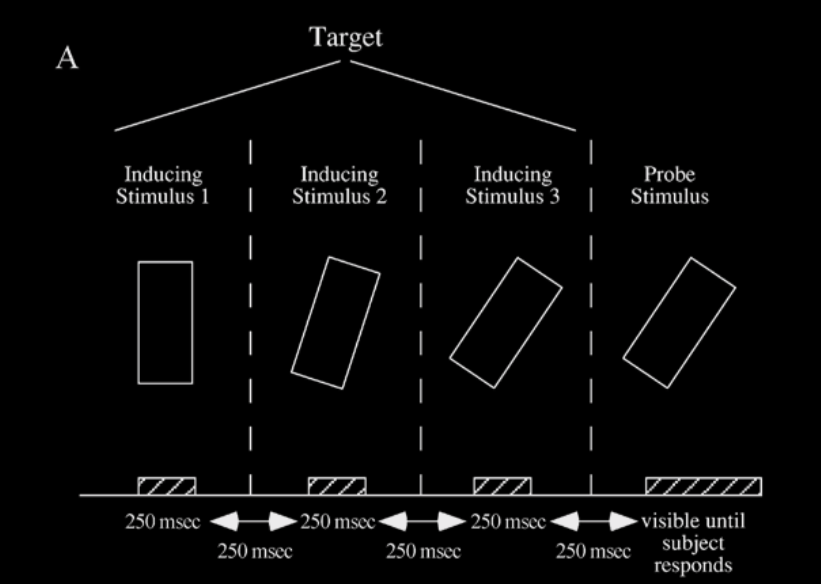

Hubbard 2005, figure 1a; redrawn from Freyd and Finke 1984, figure 1
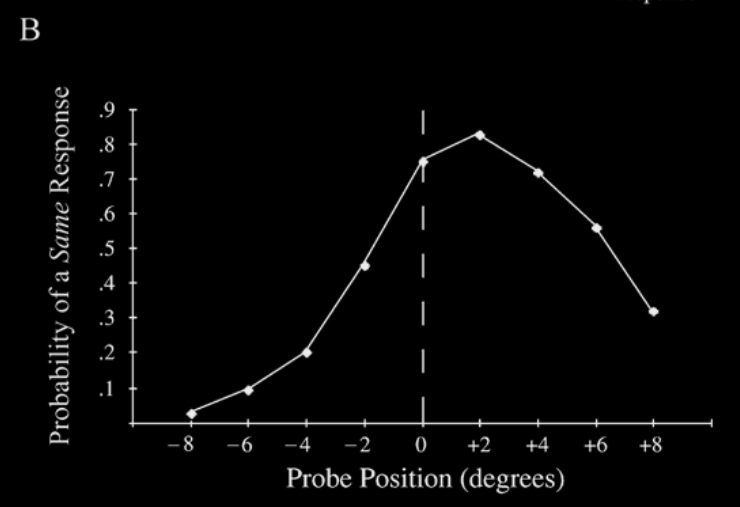
Hubbard 2005, figure 1b; drawn from Freyd and Finke 1984, table 1
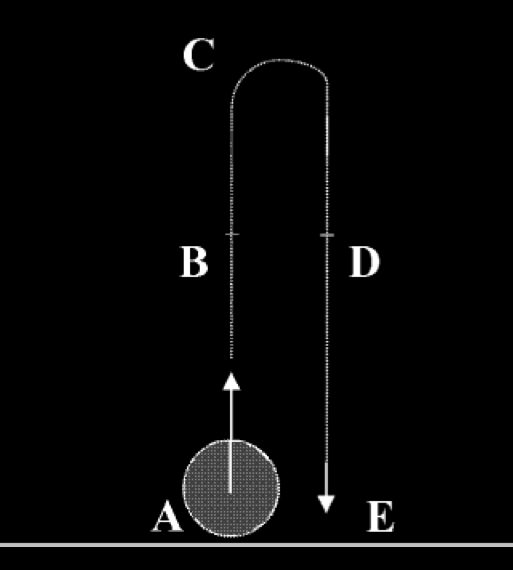
Kozhevnikov & Hegarty (2001, figure 1)
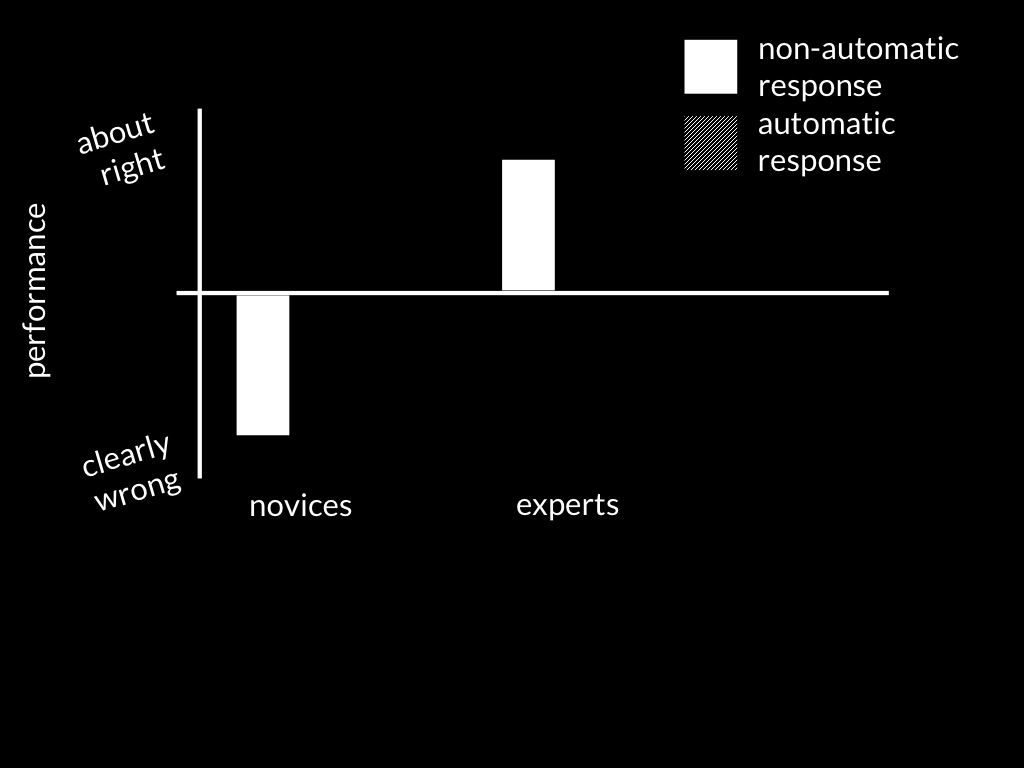
simplified from Kozhevnikov & Hegarty (2001)
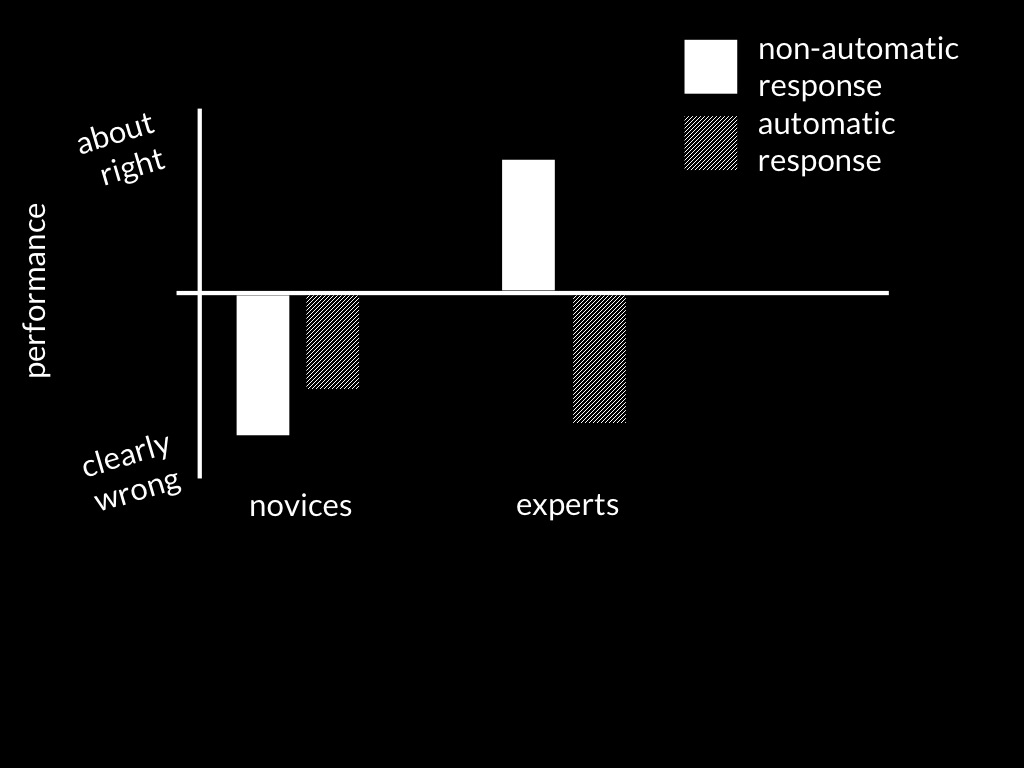
simplified from Kozhevnikov & Hegarty (2001)
‘To extrapolate objects’ motion on the basis of [e.g. Newtonian] physical principles, one should have assessed and evaluated the presence and magnitude of such imperceptible forces as friction and air resistance ... This would require a time-consuming analysis that is not always possible.
‘In order to have a survival advantage, the process of extrapolation should be fast and effortless, without much conscious deliberation.
‘Impetus theory allows us to extrapolate objects’ motion quickly and without large demands on attentional resources.’
Kozhevnikov and Heggarty (2001, p. 450)
Perceptual processes, like all cognitive processes, involve speed-accuracy trade-offs.
Being uncritically guided by perceptual processes would limit us to Aristotelian theories of the physical.
ethics?
‘Science can advance ethics by revealing the hidden inner workings of our moral judgments, especially the ones we make intuitively. Once those inner workings are revealed we may have less confidence in some of [...] the ethical theories that are explicitly or implicitly based on them’
Greene, 2014 pp. 695--6
Switch
Vicki [...] notices an empty boxcar rolling out of control. [...] anyone it hits will die. [...] If Vicki does nothing, the boxcar will hit the five people on the main track [...] If Vicki flips a switch next to her, it will divert the boxcar to the side track where it will hit the one person [...]
Flipping the switch is: [1:2:3:4:5:6:7]:[extremely morally good:::neither good nor bad:::extremely morally bad]
Switch
Vicki [...] notices an empty boxcar rolling out of control. [...] anyone it hits will die. [...] If Vicki does nothing, the boxcar will hit the five people on the main track [...] If Vicki flips a switch next to her, it will divert the boxcar to the side track where it will hit the one person [...]
Flipping the switch is: [extremely morally good:::neither good nor bad:::extremely morally bad]
Drop
Mary [...] notices an empty boxcar rolling out of control. [...] anyone it hits will die. [...] If Mary does nothing, the boxcar will hit the five people on the track. If Mary pulls a lever it will release the bottom of the footbridge and [...] one person will fall onto the track, where the boxcar will hit the one person, slow down because of the one person, and not hit the five people farther down the track.
Pulling the lever is: [extremely morally good:::neither good nor bad:::extremely morally bad]
puzzle 1
Why do people tend to respond differently in Switch and Drop?
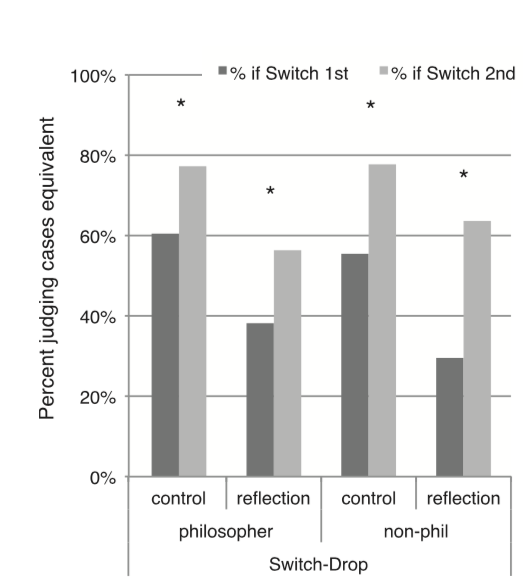
Schwitzgebel & Cushman, 2015 figure 2 (part)
puzzle 1
Why do people tend to respond differently in Switch and Drop? (And why are there order effects?)
another puzzle
Moral dumbfounding shows that some ethical judgements are not consequences of reasoning from known principles
Other phenomena (e.g. moral disengagement) indicate that some ethical judgements are consequences of reasoning from known principles
puzzle 2
Why are ethical judgements sometimes, but not always, a consequence of reasoning from known principles?

Emotion Drives Unreflective Ethical Judgements
Theoretical Claim: Emotion influences unreflective ethical judgements.
Prediction: Manipulating subjects’ emotions will influence their unreflective ethical judgements.



Schnall et al, 2008 Experiment 4
3 groups: induce disgust, sadness or neither using video clips
Judge how wrong an action is in six vignettes
Half the vignettes involve disgusting actions.
Predictions:
Disgust (but not sadness) will influence moral judgements,
irrespective of whether the actions judged are disgusting.
Complication: Private Body Consciousness
Result: ‘disgust influenced moral judgment similarly for both disgust and nondisgust vignettes’.
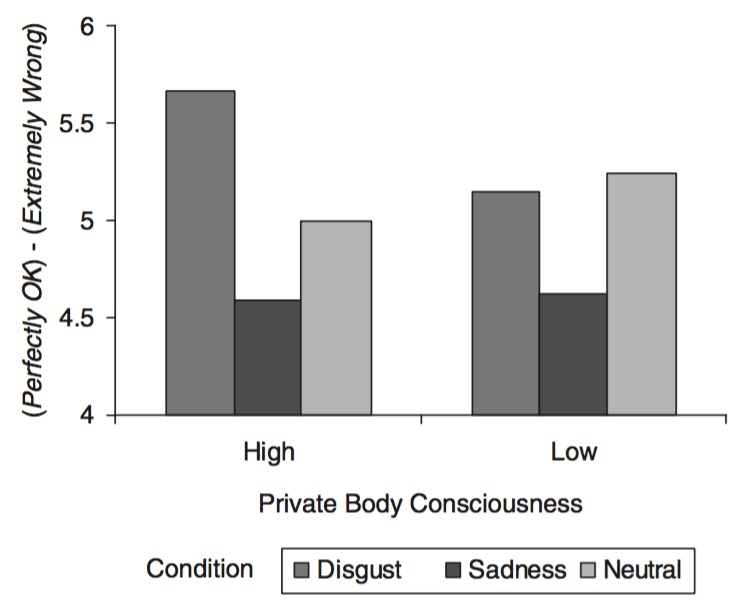

Schnall et al, 2008 figure 3
Schnall et al, 2008 conclusions:
‘the effect of disgust applies regardless of whether the action to be judged is itself disgusting.
Second, [...] disgust influenced moral, but not additional nonmoral, judgments.
Third, because the effect occurred most strongly for people who were sensitive to their own bodily cues, the results appear to concern feelings of disgust rather than merely the primed concept of disgust.
Fourth, [...] induced sadness did not have similar effects.’
Schnall et al, 2008 pp. 1105--6
Theoretical Claim: Emotion influences unreflective ethical judgements.
Prediction: Manipulating subjects’ emotions will influence their unreflective ethical judgements.

Dual Process Theories






Dual Process Theory of Ethical Abilities (core part)
Two (or more) ethical processes are distinct:
the conditions which influence whether they occur,
and which outputs they generate,
do not completely overlap.





Answer the dilemma (see handout)
Terminology
‘consequentialist response’ = yes, kill one of your fellow hostages
Additional assumptions
One process makes fewer demands on scarce cognitive resources than the other.
(Terminology: fast vs slow)
The slow process is responsible for consequentialist responses; the fast for other responses.
Prediction: Increasing cognitive load will selectively slow consequentialist responses
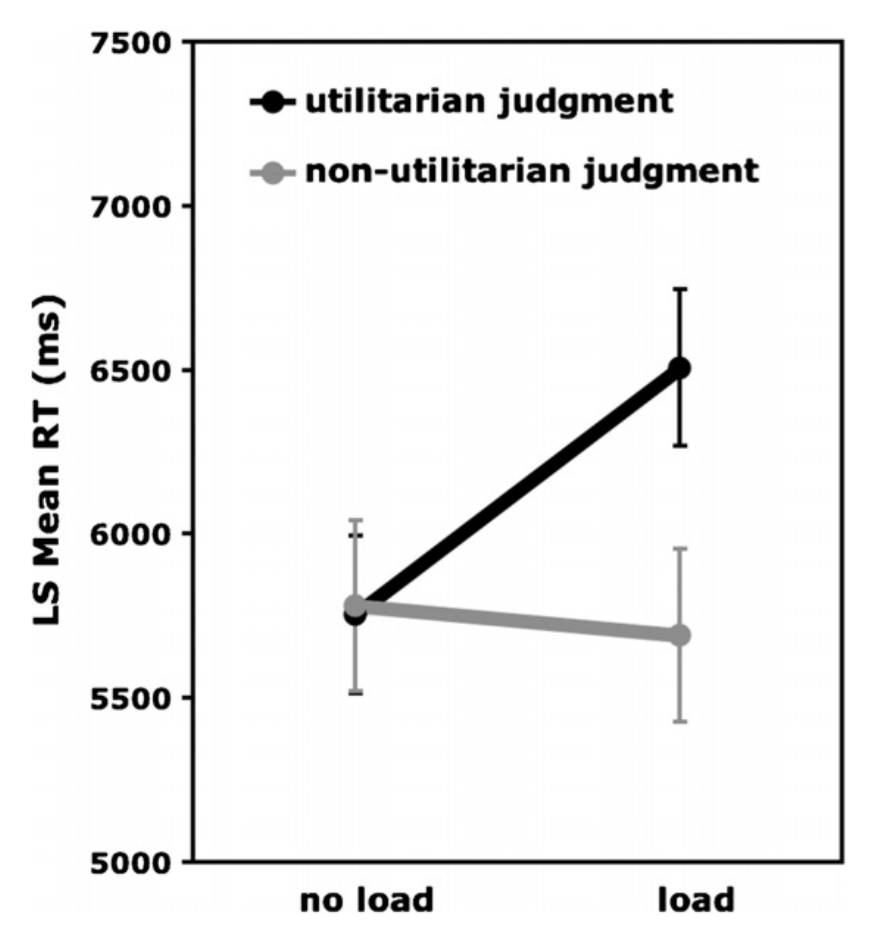
Greene et al 2008, figure 1




Additional assumptions
One process makes fewer demands on scarce cognitive resources than the other.
(Terminology: fast vs slow)
The slow process is responsible for consequentialist responses; the fast for other responses.
Prediction: Limiting the time available to make a decision will reduce consequentialist responses.
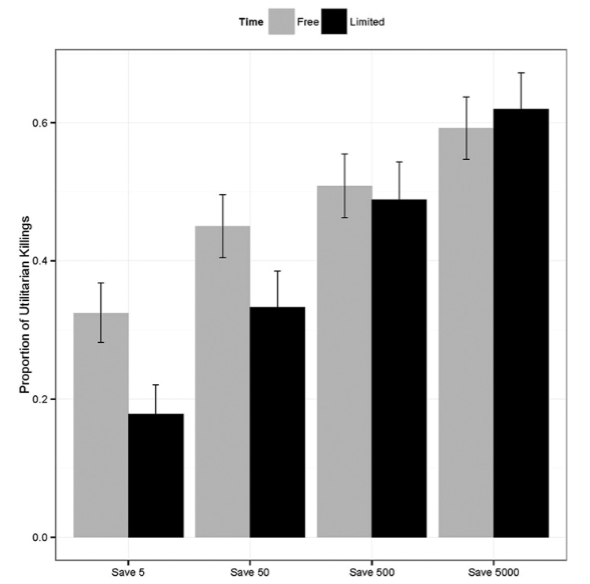

Trémolière and Bonnefon, 2014 figure 4




Dual Process Theory of Ethical Abilities (core part)
Two (or more) ethical processes are distinct:
the conditions which influence whether they occur,
and which outputs they generate,
do not completely overlap.

Dual Process Theories Meet the Puzzles
puzzle 1
Why do people tend to respond differently in Switch and Drop?
puzzle 2
Why are ethical judgements sometimes, but not always, a consequence of reasoning from known principles?


Dual Process Theory of Ethical Abilities (core part)
Two (or more) ethical processes are distinct:
the conditions which influence whether they occur,
and which outputs they generate,
do not completely overlap.
‘a dual-process approach in which moral judgment is the product of both intuitive and rational psychological processes, and it is the product of what are conventionally thought of as ‘affective’ and ‘cognitive’ mechanisms’
Cushman et al, 2010 p. 48
puzzle 1
Why do people tend to respond differently in Switch and Drop?
puzzle 2
Why are ethical judgements sometimes, but not always, a consequence of reasoning from known principles?
‘Indirect Route’
‘genetic transmission, cultural transmission, and learning from personal experience [...] are the only mechanisms known to endow [...] automatic [...] processes with the information they need to function well’
Greene 2014, p. 714
unfamiliar* problems = ‘ones with which we have inadequate evolutionary, cultural, or personal experience’
‘it would be a cognitive miracle if we had reliably good moral instincts about unfamiliar* moral problems’
‘The No Cognitive Miracles Principle:
When we are dealing with unfamiliar* moral problems, we ought to rely less on [...] automatic emotional responses and more on [...] conscious, controlled reasoning, lest we bank on cognitive miracles.’
Greene, 2014 p. 715
Switch
Vicki [...] notices an empty boxcar rolling out of control. [...] anyone it hits will die. [...] If Vicki does nothing, the boxcar will hit the five people on the main track [...] If Vicki flips a switch next to her, it will divert the boxcar to the side track where it will hit the one person [...]
Flipping the switch is: [extremely morally good:::neither good nor bad:::extremely morally bad]
Drop
Mary [...] notices an empty boxcar rolling out of control. [...] anyone it hits will die. [...] If Mary does nothing, the boxcar will hit the five people on the track. If Mary pulls a lever it will release the bottom of the footbridge and [...] one person will fall onto the track, where the boxcar will hit the one person, slow down because of the one person, and not hit the five people farther down the track.
Pulling the lever is: [extremely morally good:::neither good nor bad:::extremely morally bad]
‘I strongly suspect that [Drop] is unfamiliar*, a bizarre case in which an act of personal violence against an innocent person is the one and only way to promote a much greater good.’
Greene, 2014 p. 716

conclusion
Perceptual processes, like all cognitive processes, involve speed-accuracy trade-offs.
Being uncritically guided by perceptual processes would limit us to Aristotelian theories of the physical.
cuts